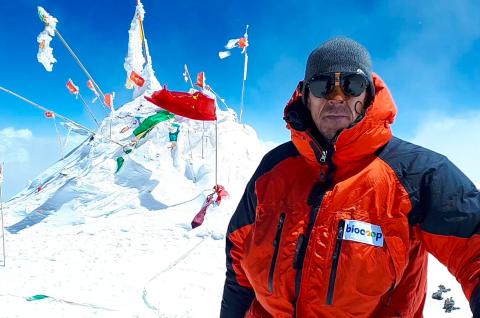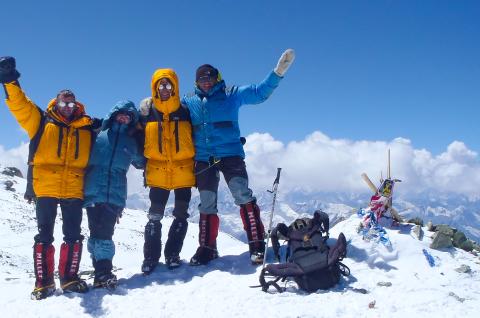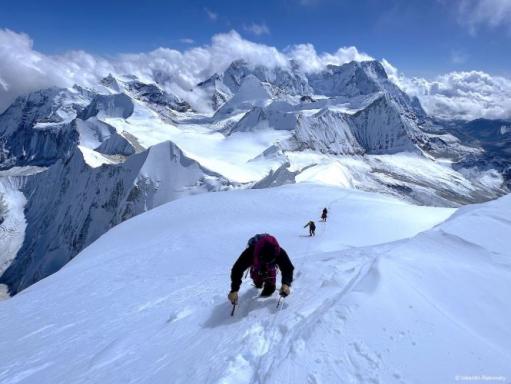We take a look back at Valentin, Dawa and Nurpu's summit day on Baruntse on 30 October. After a high-flying sporting and human adventure, our team reached the summit of this 7000-metre Nepalese peak, which is still relatively untrodden. Alone at the base camp, with an uncertain weather window, a large part of the ridge unequipped and many teams turning back at Mera La or heading straight for Amphu Lapsa, our team was rewarded for its patience and tenacity. The unexpected presence of a small Polish team also made the summit possible. Welcome to their Summit Day!
Join the next ascent of Baruntse in Nepal at 7129 m.
And check out all our climbs at 7000 meters.
Late-night awakenings and fickle weather
Sunset at C2 © Valentin Rakovsky
Good evening from base camp!
As you may have noticed from the GPS tracker, we made it to the top, but you may also have noticed that we didn't leave at all on time. We did wake up at 1am, but when Nurpu opened the entrance to the tent, the sky was completely overcast. And at that hour, the gusts of wind shook the canvas of the tent and blew the frost in our faces. Conclusion: the weather didn't allow us to leave. I woke up again at 2 a.m. and we hadn't moved; we were in the process of giving up on the summit by sleeping.
I woke up again at nearly 5am and found it hard to believe my watch that it was so late and that we hadn't even mentioned the fact that we'd given up. It had actually been a very long night (bedtime at 6pm!) and not a bad one, a real night of ‘race watch’ (in mountain vocabulary, a race means a climb) when you repeat the climb 10 times in your dreams before the real one. And this time, at 5 o'clock, we were woken up by voices in the Sherpa language: it was the two reinforcements who had arrived at the base camp at the weekend, asking us what we were doing. Down in C1, the Poles hadn't left as early as expected either. They woke up at 11.30pm, but they too waited for the weather window. It's finally here, the wind is no longer blowing, the clouds have gone and the sunrise isn't too bad.
Departure from camp 2
Dawa asked me one last time what I wanted us to do, despite the not-so-great conditions and the time we've already lost to the wind, which are jeopardising our chances. I replied as usual: ‘We're trying to go as far as possible. Not to the top, but as far as we can’. When he said ‘not to the top’, he nodded as if he understood. After so many turnarounds, we were going to have our heads spoiled by a few unexpected clouds...
By the time we'd boiled some water, had breakfast and geared up, it was already 6am. We left camp 2 3 hours 30 minutes behind schedule. Up there, the two sherpas who woke us up have gone far ahead and will take on the role of fixers, responsible for equipping the most exposed or technical passages. The Poles are an hour ahead of us, even though we were supposed to be catching up.
Departure for the summit push © Valentin Rakovsky
Oxygen deficiency
The first 400 metres of ascent are the easiest of the 700 to be climbed today. It's just a wide snow slope to climb up, before getting a foothold on the famous ridge. But it soon straightens out, with a steep first section (around 50 degrees) and then a monotonous slope at around 45 degrees, which is never-ending. I'm discovering the effects of the lack of oxygen at such an altitude. You no longer have any reference points for your walking and breathing pace, and anything can make you breathless. I managed to calm my breathing and take deep breaths, but my legs couldn't keep up. I remember counting 30 steps in a row without stopping, and finding it disgusting, as if I were pushing myself too hard.
Distances are wrong: a person 15 metres above you is in fact several minutes ahead of you. That's how we saw Lukas and then Boris slowly approaching. Lukas (who is a mountain guide and the only one of the three of us to have climbed above 7000 metres) didn't look in great shape. We shared a break, a real one, where you sit on the ground and drink a cup of tea, with Boris at around 8.10-15am. That was just before the serious stuff started. Dawa was indicating that we'd come to the end of the fixed ropes laid down by the team of fixers at the start of the season. And so our supposed U-turn.
Boris and I had a chat about the effects of oxygen deprivation. I said that, of course, everyone talks about it all the time, but it's impossible to understand unless you've been through it. Boris replied that he was finding it hard to breathe in all the way, as if the air wasn't coming in, that he couldn't take deep breaths. It didn't really fit in with my impressions, because I was able to do it. That reassured me a little about my condition. Above all, we set off again very quickly, leaving Boris and Lukas to their break, with Dawa telling me that we were about to attempt the summit. Nurpu set off far ahead with two of the Poles' sherpas to help them equip the exposed passages. So we were going to follow them, potentially all the way to the top. Knowing that you're in with a chance of winning and that there's ‘just one more thing to do’ is the kind of news that gives you wings.
The Polish team on the crest © Valentin Rakovsky
The summit ridge: a key pass
I feel like I went a lot faster from then on. From 6850m to 7000m, this is the key section of the route: a succession of small cornices and very sharp ridges. The void plunges a minimum of 1,500m on either side, and the small pieces of snow we drop as we walk roll a few metres below us and then disappear into the sheer drop. All the recipients of this email have already expressed their horror at this sort of thing, particularly Alexis, whom I've already taken on climbs of this profile ‘on the edge’, at Les Miage or L'Index.
For my part, I prefer the ridges, and it's partly for this passage that I chose the Baruntse: it's the kind of fairly pure route, in white and blue between the ground and the sky, that requires a lot of concentration and composure at the time. Above all, it's a very committed type of climb (there's no escape, and the consequences of a problem are very serious if it occurs), but very low-risk (there's very little chance of a problem occurring), because unlike a face or couloir, there are no avalanches or rockfalls on a ridge, and by definition you have nothing above you. The objective risks are therefore low, and as for the subjective risks, as the team of fixers had just put down some anchors, even if I slipped I wouldn't have gone very far. Demanding/committed but not very dangerous, that's normally what you're supposed to be looking for in the mountains.
In any case, the images of the path along the edge of the ridge are magnificent, just like the posters in ‘Montagne en scène’. I was very concentrated, much more on my feet than during the previous hour (or maybe I forgot to think about the altitude) and I had good footing, not a step out of place. I was even able to stop, take photos, turn around, look down... I found it less hard than a climb I'd done two years ago with my guide Clément in Chamonix, for an equivalent vertical drop, but on a much narrower ridge, walking on the edge and having to follow the tracks (no one had been there before and you could have walked in the footprints). I remember asking Clément at one point on the way back if we could stop talking and concentrate on my feet.
View of the ridge, looking west © Valentin Ravovsky
To the summit of Baruntse!
After this very aesthetic key passage, there was a slightly steep and very wide slope (we didn't even bother to rope up and the fixers didn't even put a rope down), 100 metres high. And then my legs were cut off, I guess as a result of the previous section, where I'd let off steam too soon. Boris and Lukas, who were almost half an hour late, got to the end almost at the same time as me, especially Lukas who seems to have had a second wind. Afterwards, he admitted to me that for the first 300 metres, he thought he wasn't going to make it. Boris made the same confession about the last 100 metres. I didn't have any strength left at that point, despite Dawa's encouragement (‘one last push and Summit!’).
After one last steep climb, we finally reached the summit ridge at around 1pm, a very wide ridge where we could take photos in all directions. By the way, I've got one with the Luxembourg flag on it. Dad, you can tell Said Kerrou 😂! All that's left is to get this great national first approved, since my climbing permit was obtained with my French passport... I suppose I'll be able to negotiate that at Namche Bazar on the way back.
Valentin and Dawa on the summit © Valentin Rakovsky
It was the end of the weather window promised by Yan, with clouds blocking our view to the west and north and hanging over us. This means no Everest in the photos, but we still had the black pyramid of Makalu (8485 m) just behind us, and it's much prettier. ‘One crowded hour of a glorious life’, as Whymper said on reaching the top of the Matterhorn.
So there were 8 of us at the top, the first to reach the summit of the Baruntse this season out of around fifty permits granted, the 645th or so to reach the summit in all (20 times less than Everest), and only the third group to make the ascent since the reopening of Nepal post-Covid. There are only 3-4 candidates left this year: Andrej, the 3rd Polish, Fritz at base camp who doesn't look in great shape and a French duo from the Basque country who are sleeping at C1 tonight and will attempt the summit on Thursday thanks to a half-window of weather, but also to the equipment that our sherpas have left in place.
The group at the top © Valentin Rakovsky
Descent back to base camp
I have far fewer images of the descent. We were caught in the clouds, sometimes we couldn't see very far ahead of us, it snowed at times so we just tried to hurry, slumping down with all our weight at every step to get down the wide slopes faster, and passing over the passages on the edge of the ridge without thinking too much.
Descent to the ridge © Valentin Ravkosky
The Poles decided to sleep again at C1. Dawa and I opted for the most comfortable possible recovery by going straight to sleep at the base camp. At C1, our two porters Tenzing and Tenjung met us and relieved us of some of our belongings. We descended the couloir below C1 (with 7-8 abseils on fixed ropes), and headed back down the glacier towards the base camp at sunset. As the air cooled, the clouds parted and the landscape was beautiful, with a post-battle atmosphere.
We retraced the route with the strength we had left, the loss of altitude helping. And so we spent the last half hour by headlamp, with a small lamp at the entrance to the base camp kitchen. A dog had probably followed the porters to the bottom of the couloir and appeared a little by surprise on the last hour of the descent to escort us back to base camp (a bit like the dog in Pirates of the Caribbean who appears with his bunch of keys in his mouth without us really knowing how).
At the end of this interminable day, almost 12.30 hours between the start at camp 2 and the return to base camp, I took very few breaks and had to make do with a Snickers bar handed to me by Dawa halfway down the descent and a litre of tea - but I probably wouldn't have wanted any more, as my wetsuit doesn't really lend itself to going to the toilet. Besides, as I don't really like to eat during exercise, I turned down the offer several times. I made up for it all with soup, spaghetti and momos back at base camp...
The return journey © Valentin Rakovsky
Well-deserved rest
It may not have been the longest ascent (I'm not sure, but I think I've already reached or exceeded 12 hours 30 minutes in the Alps), and I've already done more technical or dangerous climbs in the mountains, nor was it the scariest (compared to the June ascent of the Aiguille d'Argentière, because of the Ucpa's liabilities on it), but it was obviously my highest ascent, one of the most aesthetically pleasing and by far the most tiring. I can't remember ever being so exhausted. At least in a marathon, when you walk, you recover. Here, even stopping doesn't really recharge the batteries. I even found myself stopping out of breath when I was walking a bit fast downhill...
Now, a day of rest and holiday tomorrow, some debriefing with the Poles, and then we'll start the return journey perfectly on time. And in three days' time, I think I'll have Internet access! Mum and Dad (or anyone else for that matter), if you've got some time at the end of the afternoon when we can call each other...
Valentin in front of the sherpa gathering © Valentin Rakovsky

Climb Baruntse at 7129 meters in Nepal

Climb Muztagh Ata at 7546 meters in China


 Expeditions Unlimited blog
Expeditions Unlimited blog